
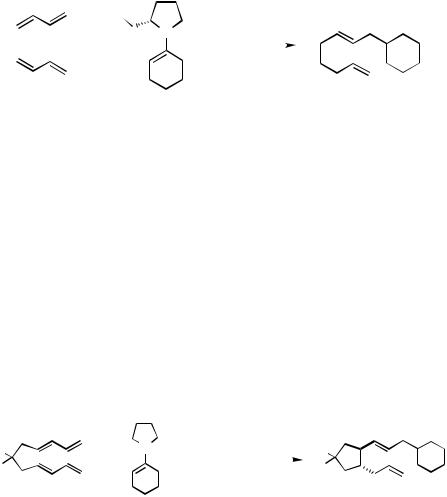
IV.10.1 Pd-CATALYZED OLIGOMERIZATION AND POLYMERIZATION |
1609 |
In a sense, pyrrole can be considered enamine-like in its reactivity, and Dzhemilev and co-workers reported that it acts as a carbon nucleophile, reacting twice with butadiene under palladium catalysis to afford 128.[141],[182]
C.xii.a. Enantioselective Trapping. Keim et al.[90],[177] evaluated the influence of chiral trapping reagents and chiral ligands on the formation of a new stereogenic center at the site of reaction on the trapping nucleophile. For example, the [Pd(OAc)2/Ph3P]-catalyzed reaction of butadiene with the (S)-2-(methoxymethyl)pyrrolidine-derived enamine of cyclohexanone 129 affords, after hydrolysis, the 2-(2,7-octadienyl)cyclohexanone (130) with 72% ee (Scheme 40). Note that the new chiral center is generated on the trapping reagent, not the dienes, and arises from asymmetric alkylation of the chiral trapping reagent by the -allylpalladium moiety.
HO |
|
|
O |
||||
N |
1. [Pd(OAc)2 / Ph3P] |
|
|
|
|
||
|
|
||||||
|
MeCN, 10 °C |
|
|
|
|
||
|
|
|
|||||
+ |
|
|
|
|
|
|
|
|
2. aq. HCl |
||||||
|
|
||||||
129 |
|
|
130 (72% ee) |
||||
|
Scheme 40 |
||||||
C.xii.b. Intramolecular Diene Coupling. Treatment of the simple bisdiene derivatives 131a – c with 2 equiv of 1-pyrrolidino-1-cyclohexene and 5 mol % [Pd(OAc)2/2 Ar3P (Ar C6H5 or o-CH3C6H4)] in refluxing methylene chloride solution effects facile carbocyclization with incorporation of the enamine trapping reagent. Hydrolysis of the crude reaction mixture yields the -alkylated cyclohexanones 132 in good to excellent yields (131a 90%, 131b 72%, 131c 83%) as mixtures of epimers with respect to the stereogenic center in the cyclohexyl ring (Scheme 41). The chemical yield and diastereoselectivity for the cyclization of bisdiene 131a are highly dependent on the solvent, ligand, and nature of the enamine. In THF or benzene solution, cycloisomerization to an enediene competes with trapping by the enamine. This side reaction is suppressed in dichloromethane, chloroform, or acetonitrile. With respect to chemical yield and reaction time required for the cyclization, triarylphosphines are superior ligands to trialkylphosphines or to phosphites. Finally, the pyrrolidinocycloalkene is superior to the morpholino derivative as the trapping reagent in trapping by either cyclohexanoneor cyclopentanone-derived enamines.
|
|
1. 5 mol % Pd(OAc)2 |
O |
||||
|
N |
|
|
|
|||
R |
2. Ar3P, CH 2Cl2, 40 °C |
R |
|||||
R |
+ |
|
|
R |
|||
2. 10% aq. HCl, 25 °C, 1 h |
|||||||
|
|||||||
|
|
72−90% overall |
|
|
|
||
131a (R = CO2Et)
132
131b (R = SO2Ph)
131c (R = CN)
Scheme 41
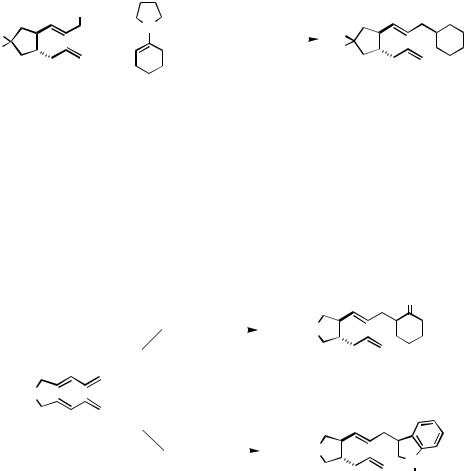
1610 |
IV Pd-CATALYZED REACTIONS INVOLVING CARBOPALLADATION |
With regard to the intramolecular reaction, it is conceivable that catalytic amounts of acetate ion in this [Pd(OAc)2/2 Ar3P]-catalyzed carbocyclization reaction serve to shuttle the bisdiene to an intermediate allylic acetate, which subsequently undergoes Pdcatalyzed reaction with the enamine. The action of the enamine trapping reagent could, in principle, be entirely independent from the carbocyclization event. In fact, treatment of the independently prepared allylic acetate 133 under the enamine carbocyclization conditions (2 equiv of 1-pyrrolidino-1-cyclohexene, 5 mol % [Pd(OAc)2/2 (o-CH3C6H4)3P], CH2Cl2, 40 °C, 5 h) gave 132a in 96% yield after hydrolysis (Scheme 42). However, the presence of acetate ion is not required for successful allylation of the enamine. Treatment of bisdiene 131a with 1-pyrrolidino-1-cyclohexene in the presence of 5 mol % Pd(acac)2 (i.e., an acetate-free palladium catalyst used in place of Pd(OAc)2) still gives 132a in 81% yield (2 (o-CH3C6H4)3P, CH2Cl2, 40 °C, 25 h). Thus, reaction via allylic acetate 133 is a viable, but not an obligatory, pathway for the conversion of bisdiene
131a to 132a.
|
OAc |
1. 5 mol % Pd(OAc)2 |
O |
||||
|
|
|
|
|
|||
E |
N |
2. Ar3P, CH 2Cl2, 40 °C, 4 h |
E |
||||
+ |
|
|
|||||
2. 10% aq. HCl, 25 °C, 1 h |
|||||||
E |
|
E |
|||||
|
|
96% overall |
|
|
|
||
|
133 |
E = CO2Et |
132a |
||||
|
|
Scheme 42 |
|
|
|
||
The benzamide bisdiene 134 proved to be a particularly good substrate for the carbocyclization with 1-pyrrolidino-1-cyclohexene. Its cyclization using 2 equiv of triphenylphosphine or tris(o-tolyl)phosphine or 1 equiv of diphenylphosphinoethane (dppe) in conjunction with Pd(OAc)2 proceeds in about 90% overall yield to the substituted N- acylpyrrolidine 135 (Scheme 43). Notably, indole also proves to be an effective trapping reagent in the reaction of 134. The adduct 136 is obtained in 91% yield from the palladium acetate-catalyzed reaction in the presence of tris(o-tolyl)phosphine.
O
|
1. 0.05 Pd(OAc)2, Ar3P |
|||||||
1-(pyrrolidino) |
|
|
|
|
|
BzN |
||
|
|
CH2Cl2, 40 °C |
|
|
||||
cyclohexene |
|
|
°C, 1 h |
|||||
2. 10% aq. HCl, 25 |
||||||||
|
||||||||
|
|
|
|
135 |
|
|||
BzN |
|
|
|
|
|
|
|
|
134 |
|
|
|
|
|
|
|
|
indole |
|
|
0.05 Pd(OAc)2, Ar3P |
|
||||
|
|
|
|
|
BzN |
|
||
|
|
CH2Cl2, 40 °C |
|
|
N |
|||
|
|
|
|
|
|
|||
136 |
H |
|
|
Scheme 43 |
|
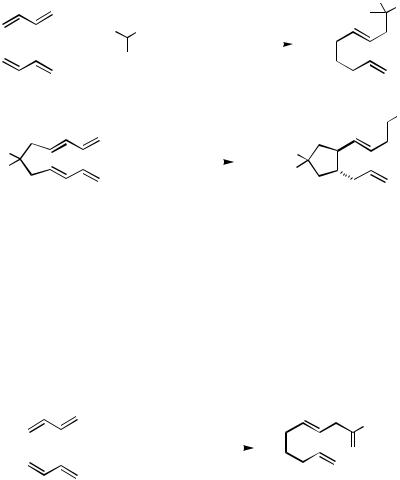
IV.10.1 Pd-CATALYZED OLIGOMERIZATION AND POLYMERIZATION |
1611 |
C.xiii. Nitroalkanes as the H—Y Trapping Reagent:
Interand Intramolecular Diene Coupling
While relatively few examples have been reported, nitroalkanes can serve as efficient carbon nucleophiles in the Pd-catalyzed linear dimerization reaction.[183] For example, butadiene reacts with 2-nitropropane (137, (Ph3P)2PdCl2, KOH, i-PrOH, 50 °C, 4 h) to afford 9- methyl-9-nitro-1,6-decadiene (138 R1, R2 Me) in 89% yield (Scheme 44). Nitromethane or primary nitroalkanes also react but can give a mixture of polyalkylation products. Keim and co-workers found that butadiene undergoes [(DIOP)Pd(OAc)2]-catalyzed dimerization with trapping by 1-nitropropane to afford 138 (R1 H, R2 CH2CH3) with 16% ee.[177]
The intramolecular diene coupling with trapping by nitromethane has also been shown to be viable.[92] Using an excess of nitromethane, polyalkylation is not a problem. Bisdiene 139 is trapped by nitromethane (0.05 [Pd(OAc)2/2 Ph3P], CH3NO2 (solvent), 60 °C) to afford cyclopentane 140 (79%, 9:1 trans/cis ring substitution).
|
|
|
|
|
|
R2 |
NO2 |
|
|
|
|
|
|
R1 |
|
|
|
|
|
|
|
|
|
Me |
Me |
(Ph3P)2PdCl2, NaOPh |
|
||||
+ |
|
|
|
||||
|
|
|
|
|
|
|
|
NO2 |
i-PrOH, 50 |
°C, 4 h |
|
||||
|
|
||||||
|
|
|
|
|
|
||
|
137 |
|
|
|
|
138 R1,R2 = Me (89%) |
|
|
|
|
|
|
|
|
NO2 |
E |
|
Pd(OAc)2, 2Ph3P |
|
E |
|
||
|
|
|
|
|
|||
E |
|
MeNO2, 60 °C, 12 |
h |
|
E |
|
|
139 |
|
E = CO2Et |
140 (79%, 9:1 trans/cis) |
|
|||
Scheme 44
C.xiv. CO/ROH, an Equivalent of “H—CO2R”as the H—Y Trapping Reagent: Intermolecular Diene Dimerization
Butadiene reacts with carbon monoxide and alcohols[184],[185] or amines[186] to form 3,8- nonadienoic acid derivatives. A variety of alcohols, even relatively bulky ones, can be used. For example, reaction of butadiene with CO (50 atm) in tert-butyl alcohol (Pd(OAc)2/4 Ph3P, 110 °C, 16 h) affords the , -unsaturated tert-butyl ester 141 in 92% yield (Scheme 45).[187] CO pressures greater than 50 atm slow the reaction as do Ph3P/Pd ratios greater than or less than 4:1.
OCMe3
[Pd(OAc)2/4 Ph3P], CO (50 atm)
t-BuOH, 110 °C, 16 h |
O |
141 (92%)
Scheme 45
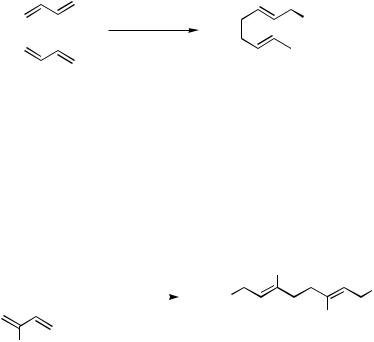
1612 |
IV Pd-CATALYZED REACTIONS INVOLVING CARBOPALLADATION |
D. DIENE DIMERIZATION WITH INCORPORATION OF SILANES, DISILANES, AND RELATED COMPOUNDS
D.i. Intermolecular Diene Dimerization
Butadiene undergoes Pd-catalyzed linear dimerization with trapping by silanes, disilanes, and distannanes to afford 2,6-octadiene derivatives (e.g., Schemes 2 and 6).[29] For example, reaction of butadiene with triethylsilane catalyzed by a phosphinated polystyrenebound palladium(0) complex affords the 1-silyl-2,6-octadiene derivative 142 (85%) (Scheme 46).[71] The highly selective formation of the 2,6- rather than 2,7-octadiene is what differentiates this class of trapping agents from the protic H—Y trapping reagents discussed above.[188]–[194] The change in regioselectivity may reflect a change in mechanism for this class of Pd-catalyzed linear dimerization reactions with subsequent trapping (vide infra). Substituted 1,3-dienes (e.g., isoprene, piperylene) give predominantly to exclusively simple hydrosilylation products rather than linear dimerization products.
Pd catalyst |
SiEt3 |
Et3SiH, 25 °C, 20 h
142 (85%)
Scheme 46
Disilane trapping reagents behave in a conceptually similar fashion.[195] Tsuji and coworkers found that a variety of simple dienes (143, e.g., butadiene, isoprene, 2-phenyl-1,3- butadiene, 2-trimethylsilyloxy-1,3-butadiene) undergo efficient Pd(dba)2-catalyzed linear dimerization disilane trapping with a variety of simple disilanes 144 to afford bis(allylsilane) products 145 (41–92% yield) (Scheme 47).[196] Cyclic disilanes afford macrocyclic bis(allylsilane) products.[197]
144 (R1 = Me, Ph, CH=CH2, CH2CH=CH |
|
|
|||
R1Me2Si |
|
SiMe2R1 |
|
R2 |
|
|
|
||||
+ |
|
5 mol % Pd(dba)2 |
|
SiMe2R1 |
|
|
|
|
R1Me2Si |
||
DMF or dioxane, 25 |
|
||||
|
|
|
°C |
||
|
|
|
|
|
R2 |
R2 |
|
145 (head-to-head dimer) |
|||
143 (R2 = H, Me, Ph, OSiMe3)
Scheme 47
There are a number of remarkable features in this very facile linear dimerization reaction with trapping by disilanes. (i) In contrast to silanes with which substituted 1,3- dienes (e.g., isoprene, piperylene) give predominantly to exclusively simple hydrosilylation products rather than linear dimerization products, disilanes afford only disilylated linear dimers—no disilylated monomer. (ii) Only the head-to-head dimerization products

IV.10.1 Pd-CATALYZED OLIGOMERIZATION AND POLYMERIZATION |
1613 |
(i.e., (E,E)-145) are observed from 2-substituted dienes (Scheme 47); this is in contrast to many other dimerization – trapping reactions of substituted dienes in which mixtures of head-to-tail dimers are formed. (iii) It is of particular note that 2-substituted 1,3-diene derivatives other than isoprene can successfully be dimerized under these conditions; for example, the 2-phenyl derivative (82% yield, R1 Me, DMF) and the 2-trimethylsilyloxy derivative (63% yield, R1 Me, DMF) afford linear dimers. However, it is reported that 2,3-dimethyl-1,3-butadiene, 1,3-pentadiene, and 1,3-cyclohexadiene do not react under these or even more vigorous reaction conditions. (iv) Other palladium catalysts work as well (e.g., Ph4Pd, (PhCN)2PdCl2, [(C3H5)Pd(cod)BF4], [(C3H5)Pd(Cl]), but Pd(dba)2 shows the highest activity. (v) DMF and dioxane are superior to benzene, toluene, THF, HMPA, or dichloromethane as reaction solvent. (vi) Finally, no crossover products are observed when reacting an equimolar mixture of disilanes 144 (R1 Me and R1 Ph) with isoprene. Both silicon atoms of the disilane trapping reagent are transferred to the same isoprene dimer, a remarkable observation given the facile Pd-catalyzed metathesis of disilanes.[198]
Tsuji and Kakehi reported the analogous linear dimerization of 1,3-dienes with subsequent trapping by distannanes.[199] For example, 1,3-butadiene undergoes efficient Pd(dba)2-catalyzed linear dimerization trapping with hexamethyldistannane (0 °C, 0.05 h) to afford 146a (78% yield) (Scheme 48). Isoprene reacts analogously (25 °C, 5 h) to afford (E,E)-146b (62% yield). Again, only the head-to-head dimerization product is observed. When the hexabutyldistannane is used in place of the hexamethyl derivative dimeric products are not formed.
|
|
|
R |
|
5 mol % Pd(dba)2 |
SnMe3 |
|
|
|
|
Me3Sn |
|
(Me3Sn)2, toluene |
||
|
R |
||
R |
|||
|
|
|
(head-to-head dimer) |
a (R = H) |
146a (R = H) |
||
b (R = Me) |
146b (R = Me) |
||
|
|
|
Scheme 48 |
D.ii. Intramolecular Diene Coupling
Treatment of bisdiene 147 with 1.5 equiv of triphenylsilane in the presence of a palladium catalyst (3 mol % Pd2(dba)3, THF, 25 °C, 1 – 2 h) effects rapid cyclization of the bisdiene.[200] A 6:1 mixture of two diastereomeric cyclopentanes, 148a and 149a, is obtained in excellent yield (94%) (Scheme 49). Similar products are obtained when dimethylphenylsilane (95%) or triethylsilane (95%) is employed. The reactions of three related bisdiene substrates have been investigated. The N-acylpyrrolidine precursor 150 (Ph3SiH, 82%), the six-membered ring precursor 151 (Ph3SiH, 80%), and the methylsubstituted bisdiene 152 (Ph3SiH, 57%) also undergo Pd-catalyzed cyclization. About 65% of the products obtained in the cyclization of 152 are derived from addition of the silyl group to the less substituted diene subunit.
The structures of diastereomers 148 and 149 are related in an unusual way. Six contiguous stereochemical centers are formed as a consequence of the carbocyclization. Yet,
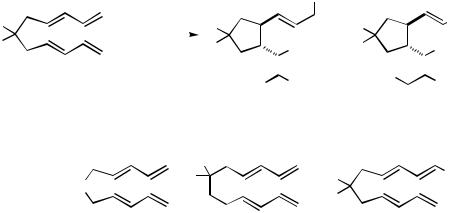
1614 |
IV Pd-CATALYZED REACTIONS INVOLVING CARBOPALLADATION |
|
|
|
|
|
|||||||
|
|
|
|
|
|
|
|
SiR3 |
|
|
|
|
|
E |
|
|
cat. Pd2(dba)3 |
E |
|
|
E |
|
|
|
|
Me |
|
|
|
|
|
|
|
|
|
|
|||||
|
|
|
|
3 |
|
|
|
|
|
|
|
|
|
E |
|
1.5 equiv H SiR |
E |
|
H |
+ E |
|
|
|
|
H |
||
147 (E = CO2Et) |
THF, 25 °C, 2 h |
Me |
|
H |
|
R3Si |
|
|
|
H |
|||
|
|
|
|
|
|||||||||
|
R = Ph (94%) |
|
|
|
|
|
|||||||
|
|
|
|
|
|||||||||
|
|
|
|
|
|
|
|||||||
|
|
|
|
|
|
|
|
|
|
||||
|
|
|
R = Et (95%) |
148a (R = Ph) |
6 : 1 |
149a (R = Ph) |
|||||||
|
|
|
|
|
|||||||||
|
|
|
|
|
148b (R = Et) |
|
149b (R = Et) |
||||||
|
|
|
|
|
E |
|
|
|
|
|
|
|
|
|
BzN |
|
E |
|
|
|
E |
|
|
|
|
Me |
|
|
|
|
|
|
|
|
E |
|
|
|
|
|
|
|
|
|
|
|
|
|
|
|
|
|
|
|
|
|
|
150 |
|
151 (E = CO2Et) |
152 (E = CO2Et) |
||||||||
|
|
|
|
|
Scheme 49 |
|
|
|
|
|
|
|
|
out of the multitude of possible stereoisomeric products, the overall configuration of the carbon skeleton is identical in both diastereomeric products. Structures 148 and 149 differ only with respect to which of the termini in the newly formed carbon skeleton the triphenylsilyl group and the hydrogen, respectively, become attached. In essence, while 148 and 149 are formally stereoisomers, they result from regioisomeric modes of H—Si addition. The Pd-catalyzed carbocyclization to assemble the carbon skeleton of the product apparently proceeds with very high levels of relative diastereoselectivity and alkene stereoselectivity. This curious relationship between 148 and 149 must somehow relate to the role of the metal in the catalytic process leading to the cyclization.
It has long been a puzzle as to why linear dimerization of butadiene with hydrosilane trapping gives 2,6-octadienes while protic H—Y trapping reagents give 2,7-octadienes. To explain the formation of 1-silyl-2,6-octadiene, it is generally postulated that the reaction proceeds via the initial partial hydrosilylation of one butadiene molecule followed by capture of the intermediate -allylpalladium complex (i.e., [ -(CH2CHCHCH3)]Pd(SiR3)Ln) by insertion of another butadiene unit. This mechanism is in contrast to the one discussed in the introductory section that has been postulated for the reaction with protic trapping reagents, that is, C—C bond formation via initial oxidative coupling of two molecules of butadiene.
The Pd-catalyzed reaction of bisdiene 147 with [D]-triphenylsilane gives the regiospecifically monodeuterated products corresponding to 148 and 149 (i.e., 153a (X D, Y SiPh3) and 154a (X D, Y SiPh3)); that is, the cyclized product picks up its hydrogen (deuterium) from the silane trapping reagent. When admixed in the absence of bisdiene 147, Pd2(dba)3 catalyzes the rapid H/D exchange and competitive dehydrogenative coupling of a mixture of deuterosilane and hydrosilane (0.03 mmol (Pd2(dba)3/0.75 mmol Ph3SiD / 0.75 mmol Me2PhSiH / 5 mL THF/25 °C/0.5 h). Nonetheless, a competition experiment in which a limiting amount of bisdiene 147 is reacted under otherwise standard conditions with a mixture of [D]-triphenylsilane and dimethylphenylsilane yields only four cyclized products (0.03 mmol (Pd2(dba)3/1.0 mmol 147 / 0.75 mmol Ph3SiD/0.75 mmol Me2PhSiH/5 mL THF / 25 °C/3 h/98% combined yield of products). Triphenylsilyl-containing products are separated from dimethylphenylsilyl-containing products by chromatography
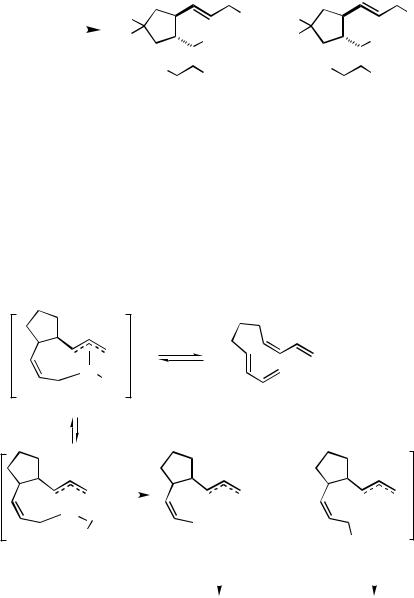
IV.10.1 Pd-CATALYZED OLIGOMERIZATION AND POLYMERIZATION |
1615 |
on silica. Analysis of the product mixture containing the triphenylsilyl moiety shows that this material also has stoichiometric deuterium incorporation; that is, a mixture of 153a (X D, Y SiPh3) and 154a (X D, Y SiPh3) is isolated (46%) (Scheme 50). Products containing the dimethylphenylsilyl moiety show no deuterium incorporation; only 153b (X H, Y SiMe2Ph) and 154b (X H, Y SiMe2Ph) are isolated (52%). This experiment shows that no crossover products are formed; both the hydrogen (or deuterium) and the silyl group come from the same molecule of silane.
|
cat. Pd2(dba)3 |
E |
|
|
|
|
|
Y |
E |
|
|
|
|
X |
||
147 |
|
|
|
|
|
|
|
|
|
|
|
|
|
|||
|
Y X |
|
E |
|
|
|
|
H |
+ |
E |
|
|
|
|
H |
|
|
|
|
|
|
|
|
|
|
|
|||||||
|
|
|
|
|
X |
|
|
|
H |
|
Y |
|
|
|
H |
|
|
|
|
|
|
|
|
|
|
|
|
|
|
||||
|
|
|
|
|
|
|
|
|
|
|
||||||
|
|
|
|
|
|
|
|
|
|
|
|
|
|
|
||
|
|
E = CO2Et |
153a (X = D, Y = SiPh3) |
|
154a (X = D, Y = SiPh3) |
|||||||||||
|
|
|
|
153b |
(X = H, Y = SiMe2Ph) |
154b (X = H, Y = SiMe2Ph) |
||||||||||
Scheme 50
The results of the crossover experiments argue against a mechanism initiated by hydrosilylation. An alternative mechanistic possibility, which is consistent with all of the data and which adequately accounts for the stereoselective formation of only diastereomers 148 and 149, is given in Scheme 51. Complexation of the silane to an initially formed palladacycle such as 155 would afford a complex such as 156. Sigma bond metathesis to a mixture of -allylpalladium complexes 157 (presumed major) and 158 (presumed minor) followed by reductive elimination from each of these would generate the observed products 148 (major) and 149 (minor).
Pd-Ln
Pd
Ln
155
H SiR3 coordination
|
|
|
|
|
|
|
|
|
|
|
|
|
and |
|
|
|
|
|
|
|
|
|
|
|
|
|
|
|
|
|
|
|
|
|
|
|
|
|
|
||
|
|
|
|
|
|
|
|
|
|
|
|
|
|
|||||||
|
|
|
|
|
|
|
|
|
|
|
|
|
|
|
|
|
|
|
|
|
Pd SiR3 |
|
|
|
|
Pd |
|
SiR3 |
|
|
|
Pd |
|
H |
|||||||
|
|
|
|
|
|
|
||||||||||||||
|
|
|
|
|
|
|
|
|
|
|
|
|
|
|
|
|
|
|||
|
H |
|
|
|
|
|
|
Ln |
|
|
|
|
Ln |
|||||||
|
|
|
|
|
|
|
|
|
|
|
|
|
|
|
SiR3 |
|||||
156 |
|
|
|
|
|
|
157 (major) |
|
|
|
158 (minor) |
|||||||||
|
|
|
|
|
|
|
|
|
|
|||||||||||
|
|
|
|
|
|
|
|
|
|
|
||||||||||
|
|
|
148 |
|
|
149 |
|
|
||||||||||||
|
|
|
|
|
|
|
Scheme 51 |
|
|
|
|
|
|
|
|
|
||||

1616 |
IV Pd-CATALYZED REACTIONS INVOLVING CARBOPALLADATION |
The Pd-catalyzed reaction of bisdiene 147, using tributylstannane in place of the hydrosilane, provides one example where tin can be used in place of silicon. The mixture of allylstannanes 159 and 160 is obtained in excellent yield (96%) (Scheme 52).
|
|
|
|
|
|
|
|
SnBu3 |
|
|
|
|
|
|
|
cat. Pd2(dba)3 |
|
|
|
|
|
|
|
|
|
Me |
|
E |
1.5 equiv H SnBu3 |
E |
|
|
|
E |
|
|
|
|
|
||
|
|
|
|
|
|
|
|
|
|
|
|
|
|
E |
|
THF, 25 °C, 2 h |
E |
|
|
H |
+ E |
|
|
|
|
H |
|
(96%) |
|
|
|
|
|
|
|
||||||
|
|
|
|
|
|
|
Bu3Sn |
|
|
|
|
||
147 |
|
E = CO2Et |
Me |
|
|
H |
|
|
|
|
H |
||
|
|
|
|
|
|
||||||||
|
|
|
|
|
|
|
|
||||||
|
|
|
|
|
159 |
|
160 |
||||||
|
|
|
Scheme 52 |
|
|
|
|
|
|
|
|
|
|
E. DIENE DIMERIZATION WITH INCORPORATION
OF A R1(R2)C"Y TRAPPING REAGENT
E.i. Introduction
At first glance the products obtained from the dimerization of dienes with R1(R2)C"Y trapping reagents (e.g., aldehydes, ketones, imines, carbon dioxide, and isocyanates),[29] especially those obtained via the cycloaddition mode, look quite different from those obtained via the other three trapping modes. Nonetheless, as illustrated in Scheme 53 for the reaction of 1,3-butadiene with a hypothetical R1(R2)C"Y trapping reagent (for simplicity, R1 R2), the products can be thought of as arising via a mechanism that is conceptually quite similar to that discussed in Sects. A–C.
Pd-catalyzed oxidative coupling of butadiene to the palladacycle 163 followed by addition of the carbon electrophile to the 1-allyl moiety in an SE2 fashion (i.e., a reaction akin to SE2 protonation in the case of proton H—Y trapping reagents) leads to a chelated - allylpalladium intermediate such as 164. At this juncture, one option is deprotonation, that is, the same pathway postulated in Sect. B to account for the intermolecular linear dimerization with trapping. Loss of the proton labeled Ha would lead to chelate 165, and upon decomplexation, triene 162. In practice, products of this sort are seen when the Pd/phosphine ratio is less than 2 (vide infra). The more common reaction mode (favored when the Pd/phosphine ratio is greater than 2) leads to the cyclized product 161. Its formation can be rationalized via decomplexation of chelate 164 to 166 followed by addition of the newly generated nucleophile Y to the 3-allylpalladium, a pathway akin to that postulated in Sect. C for trapping by protic H—Y trapping reagents, but here an intramolecular variation.
The following discussion is organized according to the nature of the R1(R2)C"Y trapping reagent employed: aldehydes and ketones, imines, and carbon dioxide and isocyanates.
E.ii. Aldehydes and Ketones as Trapping Agents:
Intermolecular Diene Dimerization
A variety of aldehydes (formaldehyde, aliphatic, and aromatic aldehydes) and some electrophilic ketones (e.g., -diketones and hexafluoroacetone) have been shown to serve as

IV.10.1 Pd-CATALYZED OLIGOMERIZATION AND POLYMERIZATION |
1617 |
+ R2C = Y
oxidative
 coupling
coupling
Pd
Ln
163
|
|
Pd |
|
|
|
|
Y |
|
|
+/or |
|
|
|
|
|
|
|
|
|
|
||||||
|
|
|
|
|
|
|
|
|
|
|
|
|
|
|
|
|
|
|
|
|
|
|||||
catalyst |
|
|
|
|
|
R |
|
|
|
|
|
|
|
|
|
|
||||||||||
|
|
|
C |
|
|
|
|
|
|
|
|
|
|
|
|
|
|
|
|
|||||||
|
|
|
|
|
|
|
|
|
R |
|
|
|
|
R |
|
C |
|
|
||||||||
|
|
|
|
|
|
|
|
|
|
|
|
|
|
|
|
|
|
|||||||||
|
|
|
|
|
|
|
|
|
|
|
|
|
|
|
|
|
|
|||||||||
|
|
|
|
|
|
|
|
|
|
|
|
|
|
|
|
|
R |
|
|
|
YH |
|
|
|||
|
|
|
|
|
161 |
|
|
|
|
|
|
|
|
|
|
|
|
|
|
|
|
|
|
|||
|
|
|
|
|
|
|
|
|
|
|
|
|
|
162 |
|
|
|
|
|
|
||||||
|
|
|
|
|
|
|
|
|
|
|
|
|
|
|
|
|
|
|
|
|
|
|
|
|
|
|
|
|
|
|
|
|
Ha |
|
|
|
|
|
|
|
|
|
|
– Ha+ |
|
|
|||||||
|
|
|
|
|
|
|
|
|
|
|
|
|
|
PdLn |
|
|
|
|
PdLn |
|||||||
|
+ (R2C = Y) |
|
|
|
|
|
|
|
|
|
|
|
|
|
|
|
|
|
|
|||||||
|
|
|
|
|
|
|
|
|
|
|
|
|
|
|
|
|
|
|
|
|
|
|
||||
|
|
|
|
|
|
|
|
|
|
|
|
|
|
|
E2 |
|
|
|||||||||
|
|
|
|
|
|
|
|
|
|
|
|
|
|
|
|
|
|
|
|
|
|
|||||
|
|
SE2′ |
|
|
|
|
R |
C |
|
|
– |
|
|
|
|
|
|
|
R |
C |
||||||
|
|
|
|
|
|
|
|
|
Y |
|
|
|
|
|
|
|
||||||||||
|
|
|
|
|
|
|
|
|
|
R |
|
|
|
|
|
|
|
R |
YH |
|||||||
|
|
|
|
|
|
|
|
|
|
|
|
164 |
|
|
|
|
|
|
|
|
|
165 |
||||
|
|
|
|
|
|
|
|
|
|
|
|
|
+ L |
|
|
|
|
|
|
|
|
|
|
|||
|
|
|
|
|
|
|
|
|
|
|
|
|
|
|
|
|
|
|
|
|
|
|
||||
|
|
|
|
|
|
|
|
|
|
|
|
|
|
|
|
|
|
|
|
|
|
|
||||
|
|
|
|
|
|
|
|
|
|
|
|
|
|
|
|
|
|
|
|
|
|
|
|
|
162 |
|
|
|
|
|
|
|
|
|
|
|
|
|
|
|
|
|
|
|
|
|
|
|
|
|
|
||
|
|
|
|
|
|
|
|
|
|
|
–Y |
PdLn |
|
|
|
|
|
|
|
|
|
|||||
|
|
|
|
|
|
|
|
|
|
|
|
|
|
|
|
|
|
|
|
|
|
|||||
|
|
|
|
|
|
|
|
|
|
|
|
|
|
|
|
|
|
|
|
161 |
|
|
||||
|
|
|
|
|
|
|
|
|
|
|
|
|
|
|
|
|
|
|
|
|
|
|||||
|
|
|
|
|
|
|
|
|
|
|
C |
|
R |
|
|
|
|
|
|
|
|
|
|
|
||
|
|
|
|
|
|
|
|
|
|
|
|
|
|
|
|
|
|
|
|
|
|
|
||||
|
|
|
|
|
|
|
|
|
|
|
|
|
R |
|
|
|
|
|
|
|
|
|
|
|
||
|
|
|
|
|
|
|
|
|
|
|
166 |
|
|
|
|
|
|
|
|
|
|
|
|
|
||
|
|
|
|
|
|
|
|
|
|
|
|
|
|
|
|
|
|
|
|
|
|
|
|
|||
|
|
|
|
|
|
|
|
Scheme 53 |
|
|
|
|
|
|
|
|
|
|
||||||||
trapping reagents.[201]–[204] The formation of linear or cyclic products depends on the Pd/phosphine ratio. For example, the reaction of butadiene with acetaldehyde (Pd(acac)2, n Ph3P, 25 °C, 60 h, ca. 0.5–2.0 mmol Pd/mol butadiene) in the presence of 4 equiv of Ph3P per Pd affords predominantly 167 (70% yield) (Scheme 54).[201] The same reaction run in the presence of 1 equiv of Ph3P per Pd affords predominantly 168 (70% yield). The reaction is said to be more facile when run in an alcohol solvent, as illustrated by the following two sets of reaction conditions: (i) (Pd(acac)2, 4 Ph3P, EtOH, 80 °C, 2 h) yields 167 (74%) and 168 (6%); and (ii) (Pd(acac)2, 1 Ph3P, i-PrOH, 80 °C, 3 h) yields 167 (8%) and 168 (75%).
H
+ |
|
|
O |
Pd |
O |
or |
|
|
|
|
|
|
|||
Me |
|
catalyst |
|
||||
|
|
|
|
Me |
|||
|
|
|
|
|
|
||
|
|
|
|
|
|
|
|
Me OH
OH
167 |
168 |
Scheme 54
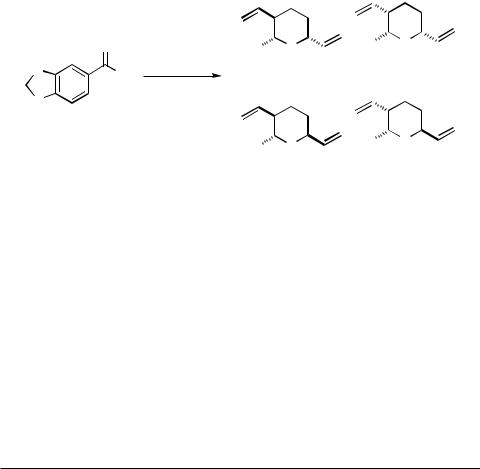
1618 |
IV Pd-CATALYZED REACTIONS INVOLVING CARBOPALLADATION |
In general, when the reaction is run so as to favor formation of the cyclic (here, divinyltetrahydropyran) product, a mixture of four racemic diastereomers is formed. For example, butadiene reacts with aromatic aldehydes such as 3,4-(methylenedioxy)ben- zaldehyde to afford a 33:33:24:10 mixture of substituted divinylpyrans (169–172) in high yield (70–95%) (Scheme 55).[205],[206]
O |
Ar |
O |
Ar |
O |
|
|
|||
O |
1,3-butadiene |
169 |
|
170 |
|
H |
|
|
|
|
[Pd(OAc)2 / Ph3P] |
|
|
|
O |
i-PrOH |
|
|
|
(95%) |
|
|
|
|
|
|
|
|
|
|
Ar |
O |
Ar |
O |
|
|
|
||
|
|
171 |
|
172 |
Scheme 55
E.ii.a. Enantioselective Catalysis. Keim and co-workers examined the enantioselective butadiene dimerization with aldehyde trapping. For example, Pd-catalyzed reaction of butadiene with formaldehyde (0.02 mol % Pd(OAc)2, 0.03 mol % chiral diphosphine, i-PrOH, 20 °C, 40 h) affords a mixture of cis- and trans-divinyltetrahydropyrans, 173 and 174, respectively.[177],[207] (The absolute configurations of 173 and 174 were not assigned by the authors; the configurations illustrated in Scheme 56 were chosen arbitrarily.) Table 1 summarizes the results obtained for several chiral phosphines. The reaction with formaldehyde affords a 2.6–5.6:1 ratio of trans- and cis-2,5-divinyltetrahydropyran in 25–65% chemical yield. Among the chiral ligands examined, DIOP (173 18% ee; 174 26% ee), NORPHOS (173 3% ee; 174 36% ee), and neo-MenPPh2 (173 13% ee; 174 30% ee) gave the highest levels of enantioselectivity.
TABLE 1. Enantioselective Dimerization of Butadiene Followed by Trapping with Formaldehyde
Chiral Liganda |
Yield (%) |
173/174 |
173 ee (%) |
174 ee (%) |
( )-DIOP |
65 |
5.0 : 1 |
18 |
26 |
( )-DIOP |
64 |
5.5 : 1 |
17 |
25 |
BPPM |
45 |
2.6 : 1 |
2 |
5 |
CIRA |
30 |
3.6 : 1 |
15 |
20 |
NORPHOS |
55 |
5.6 : 1 |
3 |
36 |
NMDPP |
25 |
3.9 : 1 |
13 |
30 |
PHEN |
45 |
3.9 : 1 |
5 |
24 |
|
|
|
|
|
aBPPM (2S,4S )-N-t-butoxycarbonyl-2,4-bis(diphenylphosphino)methylpyrrolidinone; CIRA (2R,3R)-2,3- bis(diphenylphosphinobutane); NORPHOS (2R,3R)-2,3-bis(diphenylphosphino)bicyclo[2.2.1]hept-5-ene; NMDPP (1R,2R,5S)-neomenthyldiphenylphosphine; PHEN (R)-1,2-bis(diphenylphosphino)-3-phenyl- propane.
